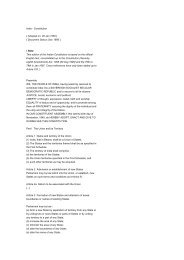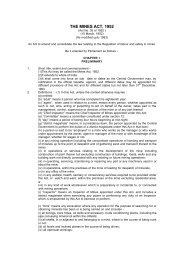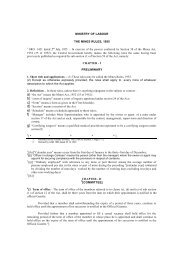Annual Report,2009 - Directorate General of Mines Safety
Annual Report,2009 - Directorate General of Mines Safety
Annual Report,2009 - Directorate General of Mines Safety
Create successful ePaper yourself
Turn your PDF publications into a flip-book with our unique Google optimized e-Paper software.
DGMS <strong>Annual</strong> <strong>Report</strong>, <strong>2009</strong><br />
A standard 120 V, 100 watt incandescent light bulb emits 1500–1700 lumens, while a<br />
standard 230 V model emits 1200–1400 lm. A 23 watt compact fluorescent lamp<br />
emits about 1500 lm. The number <strong>of</strong> lumens produced per watt <strong>of</strong> power consumed is<br />
the wall-plug luminous efficacy <strong>of</strong> the source.<br />
Difference between lumens and lux<br />
The difference between the units lumen and lux is that the lux takes into account the<br />
area over which the luminous flux is spread. A flux <strong>of</strong> 1000 lumens, concentrated into<br />
an area <strong>of</strong> one square meter, lights up that square meter with an luminance <strong>of</strong> 1000<br />
lux. The same 1000 lumens, spread out over ten square meters, produce a dimmer<br />
luminance <strong>of</strong> only 100 lux.<br />
Achieving an luminance <strong>of</strong> 500 lux might be possible in a home kitchen with a single<br />
fluorescent light fixture with an output <strong>of</strong> 12000 lumens. To light a factor floor with<br />
dozens <strong>of</strong> times the area <strong>of</strong> the kitchen would require dozens <strong>of</strong> such fixtures. Thus,<br />
lighting a larger area to the same level <strong>of</strong> lux requires a greater number <strong>of</strong> lumens.<br />
Luminance<br />
It is the total amount <strong>of</strong> visible light illuminating (incident upon) a point on a surface<br />
from all directions above the surface. This “surface” can be a physical surface or an<br />
imaginary plane. Therefore luminance is equivalent to irradiance weighted with the<br />
response curve <strong>of</strong> the human eye.<br />
Standard unit for luminance is Lux (lx), which is lumen per square meter (lm/m 2 ).<br />
1 lx = 10.764 fc Footcandle : fc<br />
Horizontal luminance<br />
The measure <strong>of</strong> brightness from a light source, usually measured in footcandles or<br />
lumens, which is taken through a light meter‟s sensor at a horizontal position on a<br />
horizontal surface.<br />
Vertical luminance<br />
The measure <strong>of</strong> brightness from a light source, usually measured in footcandles or<br />
lumens, which is taken through a light meter‟s sensor at a vertical position on a<br />
vertical surface.<br />
Uniformity Ratio<br />
It describes the uniformity <strong>of</strong> light levels across an area. This may be expressed as a<br />
ratio <strong>of</strong> average to minimum or it may be expressed as a ratio <strong>of</strong> maximum to<br />
minimum level <strong>of</strong> illumination for a given area.<br />
Example :- U. ratio max. to min. = 4:1 for the given area, the lowest level <strong>of</strong><br />
illumination (1) should be no less than ¼ or “4 times less” than the maximum (4)<br />
level <strong>of</strong> illumination.<br />
The maximum brightness contrast <strong>of</strong> juxtaposed surfaces in the normal visual field<br />
should be preferably not greater than 20 to 1; that is to say, the darkest part <strong>of</strong> the<br />
160
















